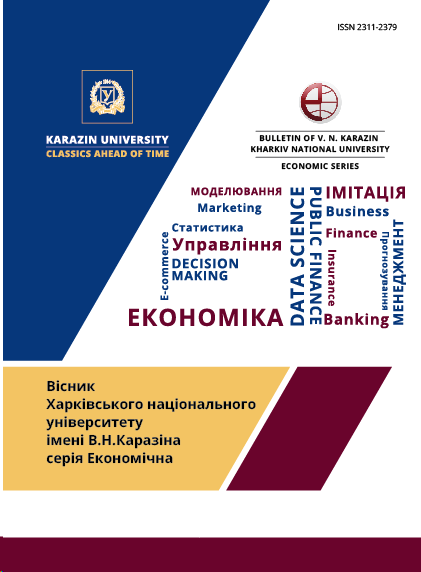Alternative energy in Ukraine. System dynamics methodology in RES research
Abstract
The growing demand for electricity, which is expected to double by 2030 and quadruple by 2050 compared to 2000, underlines the urgent need for widespread deployment of renewable energy sources (RES) such as wind, solar, bioenergy, hydro and geothermal ones. Initiatives of many countries reflect the growing recognition of the need of transition to sustainable energy systems. According to the UN, Sustainable Development Goal 7 is "to ensure access to affordable, reliable, sustainable and modern energy for all". The paper examines the foreign experience of mixed energy development strategies and discusses the hypotheses of RES impact on key processes taking place in various spheres of life. In Ukraine, the transition to renewable energy is vital due to not only ecological or economic necessity, but also to a strategic one. According to the updated energy strategy of Ukraine until 2030, alternative energy should make up 25% of the total energy production, which corresponds to the country's obligations to the European Energy Community. But Ukraine faces a number of economic barriers that prevent deployment of renewable energy sources. These include high initial investment costs, unstable public policy frameworks and limited access to necessary financing, which together create a difficult investment climate that discourages domestic and foreign investors. By the start of the war in 2022, renewable energy sources accounted for about 13.4% of total energy production in Ukraine. However, the destruction of energy infrastructure throughout the country, including that of the renewable energy sector, led to a sharp decrease in this indicator up to 5-6%. A special attention in this study is paid to the use of the System Dynamis (SD) concept of simulation in RES research. Analysis of the latest publications and reference models testify to the effectiveness of the SD methodology and allowed to form the base model assumptions. Paper presents a structural SD model for the analysis of the implementation of renewable energy in Ukraine, taking into account the complex interaction of economic, social and environmental challenges to assess the long-term potential consequences of the transition to RES.
Downloads
References
Renewable Energy Performance Index. (2023). Retrieved from https://coincub.com/ranking/renewable-energy-performance-index-2023/
Demchenkov, Y. (2022). How the war in Ukraine accelerates the EU's transition to renewable energy sources. Retrieved from https://www.epravda.com.ua/columns/2022/05/12/686934/ (in Ukrainian)
Ministry of Energy of Ukraine. (2024). Herman Galushchenko on the International Day of Clean Energy: the Ukrainian energy industry is increasing RES capacity and will become climate neutral. Retrieved from https://mev.gov.ua/novyna/herman-halushchenko-u-mizhnarodnyy-den-chystoyi-enerhiyi-ukrayinska-enerhetyka-naroshchuye (in Ukrainian)
Konechenkov А. (2022). Renewable energy sector of Ukraine before, during and after the war. Razumkov centre. Retrieved from https://razumkov.org.ua/statti/sektor-vidnovlyuvanoyi-energetyky-ukrayiny-do-pid-chas-ta-pislya-viyny (in Ukrainian)
Dixi Group. (2023). Renewable energy development until 2030: EU goals and Ukraine's plans. Retrieved from https://dixigroup.org/comment/rozvytok-vde-do-2030-roku-czili-yes-ta-plany-ukrayiny/
Ministry of Economy of Ukraine. (2024). National Energy and Climate Plan of Ukraine 2025-2030. Retrieved from https://www.me.gov.ua/Documents/Download?id=e79ecda3-f092-4d36-b600-21083ee61fa8 (in Ukrainian)
Economic truth. (2023). What is left of "green" energy in Ukraine. Retrieved from https://www.epravda.com.ua/publications/2023/05/24/700431 (in Ukrainian)
Bartoszczuk, P. (2004). System dynamics economic model with fossil and renewable energy. In SD Conference Proceedings. Retrieved from https://proceedings.systemdynamics.org/2006/proceed/papers/BARTO295.pdf
Fiddaman, T.S. (1997). Feedback complexity in integrated climate-economy models. Sloan School of Management, MIT, Cambridge.
de Gooyert, V. (2023). Key enablers and barriers for a climate neutral energy system in the Netherlands in 2050. In SD Conference Proceedings. Retrieved from https://proceedings.systemdynamics.org/2023/papers/O1123.pdf
Loh, J.R., & Bellam, Sr. (2024). Towards net zero: Evaluating energy security in Singapore using system dynamics modelling. Applied Energy, 358. doi: https://doi.org/10.1016/j.apenergy.2023.122537
Nair, K. et al. (2021). Developing a system dynamics model to study the impact of renewable energy in the short- and long-term energy security. Materials Science for Energy Technologies, 4, 391-397. doi: https://doi.org/10.1016/j.mset.2021.09.001
Shadman, S. et al. (2022). A system dynamics approach to pollution remediation and mitigation based on increasing the share of renewable resources. Environmental Research, 205, 112458. doi: https://doi.org/10.1016/j.envres.2022.112458
Mashhadi, Z. (2021). Can Germany move towards 100% renewable electricity without major problems? Retrieved from https://proceedings.systemdynamics.org/2021/papers/P1053.pdf
Schoenberg, W. et al. (2023). Towards a fully coupled integrated climate assessment model: FRIDA Version 0.1. Retrieved from https://proceedings.systemdynamics.org/2023/papers/O1133.pdf
Energy Monitor. (2023). The ten countries that produce the world’s cleanest electricity. Retrieved from https://www.energymonitor.ai/sectors/power/the-top-ten-cleanest-power-grids-countries/?cf-view
Sani, K. et al. (2018). Indonesia Energy Mix Modelling Using System Dynamics. International Journal of Sustainable Energy Planning and Management, 18, 29-51. doi: https://doi.org/10.5278/ijsepm.2018.18.3
Way, R. et al. (2022). Empirically grounded technology forecasts and the energy transition. Joule, 6. doi: https://doi.org/10.1016/j.joule.2022.08.009
Ghezelbash, A. et al. (2023). Impacts of green energy expansion and gas import reduction on South Korea’s economic growth: A system dynamics approach. Sustainability, 15(12), 9281. doi: https://doi.org/10.3390/su15129281
Donges, J. F. et al. (2021). Taxonomies for structuring models for World–Earth systems analysis of the Anthropocene: subsystems, their interactions and social–ecological feedback loops. Earth System Dynamics, 12, 1115-1137. doi: https://doi.org/10.5194/esd-12-1115-2021
Friedlingstein, P. et al. (2023). Global carbon budget 2023. Earth System Science Data, 15, 5301-5369. doi: https://doi.org/10.5194/essd-15-5301-2023
Laimon, M. et al. (2022). A systems thinking approach to address sustainability challenges to the energy sector. International Journal of Thermofluids, 15. doi: https://doi.org/10.1016/j.ijft.2022.100161
Laimon, M. et al. (2020). Energy Sector Development: System Dynamics Analysis. Applied Sciences, 10(1), 134. doi: https://doi.org/10.3390/app10010134
Kelly, C., Onat, N. C., & Tatari, O. (2019). Water and carbon footprint reduction potential of renewable energy in the United States: A policy analysis using system dynamics. Journal of Cleaner Production, 228, 910-926. doi: https://doi.org/10.1016/j.jclepro.2019.04.268
Steffen, B. et al. (2020). Experience Curves for Operations and Maintenance Costs of Renewable Energy Technologies. Joule, 4(2), 359-375. doi: https://doi.org/10.1016/j.joule.2019.11.012
Vartiainen, E. et al. (2019). Impact of weighted average cost of capital, capital expenditure, and other parameters on future utility-scale PV levelized cost of electricity. Progress in Photovoltaics: Research and Applications, 27(11), 965-977. doi: https://doi.org/10.1002/pip.3189
Copyright (c) 2024 Bitkova T., Manakhov K.

This work is licensed under a Creative Commons Attribution 4.0 International License.

